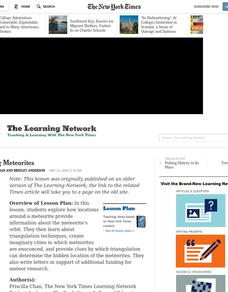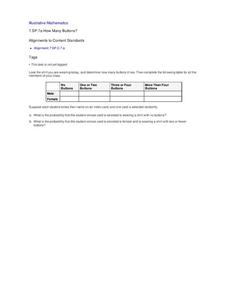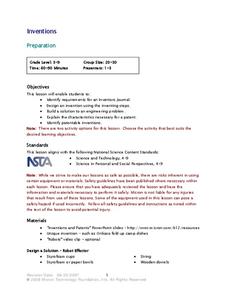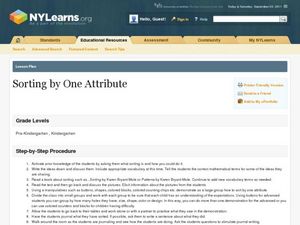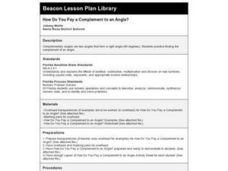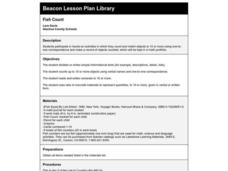Curated OER
And the Winner Is...
Young scholars read the sports section of the daily newspaper to find daily totals of what countries have won medals and find articles to keep in their journal (notebook) on the different events and athletes. They then create a...
Curated OER
Berlioz the Bear
Young children read the story, Berlioz the Bear and complete various reading and writing activities. They learn about fiction and non-fiction, and complete graphing and writing activities for the story. Youngsters draw the bear and use...
Curated OER
Do You Have a Blog?
Ask learners about their personal writing habits, such as whether they keep a journal or a blog, or if they'd ever want to. Though this is not a fully developed lesson, you can use this article and question to provoke discussion and...
Curated OER
Mapping Meteorites
After reading an article, "Cameras Capture a 5-Second Fireball and Its Meteorite's Secrets," space science superstars use the triangulation method to determine the location of a distant object. In-class activities and homework are...
Curated OER
How Many Buttons
Help learners explore the concepts of more than, less than, and equal to. They participate in a button attribute activity, play a game using buttons and a die, draw the sets of buttons in their journal, and play button bingo.
Curated OER
Inventions
Students study invention steps and design their own invention. In this invention lesson, students discuss inventions and the process of inventing. Studnets write in an inventor's journal and study various types of inventions. Students...
Curated OER
Out of Sight Missing Addends
Students explore solving missing addend problems. Using manipulatives, students solve addition problems. They create a picnic basket-shaped math journal and write a summary of their activities. Students write number sentence that match...
Curated OER
Sorting By One Atrribute
Students use different color items to sort by color and different attributes of the manipulatives given to them. In this sorting lesson plan, students also write a journal entry or draw a picture of their activity.
Curated OER
Being Equal is No Monkey Business
First graders study what an equation is before working to determine how to divide an odd number of items in an equitable way. They divide equations into those that are true and those that are not while two students act as the king and...
Curated OER
Question of the Day Counting
First graders answer daily questions, then count to see how many responded with yes or no. They record their answers in math journals and discuss the results.
Curated OER
Little Pigs with Big Problems
First graders solve one problem per day regarding the story of Three Little Pigs. In this math journals lesson plan, 1st graders solve problems on a daily basis using the story of the Three Little Pigs.
Curated OER
Graphs
Eighth graders analyze graphs on a worksheet and in newspapers and magazines. In this graphs lesson plan, 8th graders also record their thoughts in a journal.
Curated OER
Algebra Applies to the Real World? No Way!
Sixth graders examine the connections between math and real life. For this algebra lesson, 6th graders use Algepairs Cards to complete the problems presented and discuss how algebra relates the real world.
Curated OER
How Do You Pay a Complement to an Angle?
Learners observe and solve examples of the complementary angle theorem. They complete the How Do You Pay a Complement to an Angle worksheet, and write a response in their math journal.
Helping with Math
Solving Equations with Two-Stepping! (2 of 4)
Multi-step problems are part of the progression when learning to solve equations. These 12 problems require only two steps to arrive at an answer. Either print the page out to assign as homework, or have learners write down the problems...
University of California
Euclidean Geometry
Go back to where it all began! Investigate how axiomatic systems and Euclidean geometry are based on undefined terms, common notions, postulates, and propositions by examining passages from Euclid's Elements. (Social studies teachers...
Statistics Education Web
Which Hand Rules?
Reaction rates vary between your dominant and nondominant hand ... or do they? Young scholars conduct an experiment collecting data to answer just that. After collecting data, they calculate the p-value to determine if the difference is...
EngageNY
An Appearance of Complex Numbers 1
Complex solutions are not always simple to find. In the fourth lesson of the unit, the class extends their understanding of complex numbers in order to solve and check the solutions to a rational equation presented in the first lesson....
Statistics Education Web
How High Can You Jump?
How high can your pupils jump? Learners design an experiment to answer this question. After collecting the data, they create box plots and scatter plots to analyze the data. To finish the instructional activity, they use the data to...
Curated OER
The Daily News
Students complete a news writing activity and improve their writing skills. In this news writing instructional activity, students write about an activity they experience each day of the week. Students use the articles to make a newspaper...
Curated OER
You Are Here
Learners determine the relative size and distance of the planets in the solar system. They use ratios in their mathematical calculations to make models of the planets after discussing the relative sizes of the planets. They keep a...
Curated OER
Time Changes Everything
Students analyze census data from 1915, 1967 and 2006. They read an article about how the world's population is growing at an alarming rate. They use primary source documents to create a timeline on the information they gathered. They...
Curated OER
Fish Count
Students participate in hands-on activities in which they count and match objects to 10 or more using one-to-one correspondence and make a record of objects counted, which be kept in a math portfolio.
Curated OER
Comparing/Ordering Numbers
Third graders compare numbers. In this math lesson students compare ones, tens, and hundreds. They also order numbers from least to greatest and from greatest to least.





